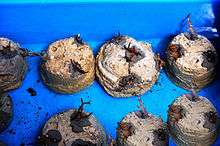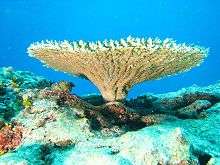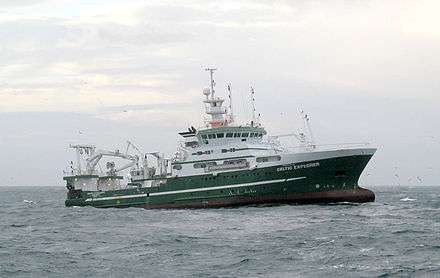Aquaculture of coral

Coral aquaculture, also known as coral farming or coral gardening, is the cultivation of corals for commercial purposes or coral reef restoration. Aquaculture is showing promise as a tool for restoring coral reefs, which are dying off around the world.[1][2][3] The process protects young corals while they are most at risk of dying. Small corals are propagated in nurseries then replanted on the reef.[4]
Coral farmers live near the reefs they farm and work for reef conservation or for income. Coral is also farmed by scientists for research, by businesses for the live and ornamental coral trade, and by private aquarium hobbyists.
Coral reef farming is the extracting of part of a coral colony or free-floating larva from a reef and growing them in a nursery until adulthood. It is commonly referred to as the "gardening method" and has been compared to silviculture as a management practice that mimics natural ecosystems.[3][5]
Adult corals can be transplanted onto a reef, usually a damaged area.[3][6] Coral is farmed for conservation reasons in the Philippines, Solomon Islands, Palau, Fiji, Marshall Islands and Japan. Land-based coral farming occurs in public aquariums in North America and Europe.[7]
Reefs in decline
Coral is an important foundation species. While it covers less than one percent of the ocean surface, it provides habitat for nearly one third of saltwater fish species, as well as ten percent of all fish captured for human consumption.[7]
Reefs are affected by severe weather events, such as cyclones,[8] from predation by crown of thorns starfish and from competition for habitat with other foundation species such as seaweed. Seaweed can take over coral habitat when the water contains excess nutrients (nitrogen and phosphorus) or when fishing stocks are too low and herbivorous fish do not keep the seaweed at bay by eating it.[6]
Natural stressors to the coral reef are further aggravated by the human impact on coral reefs. Anthropogenic stressors such as runoff, coastal development, dynamite fishing, cyanide fishing, overexploitation of resources and marine pollution, put 58% percent of the world's reefs under threat as of 2009.[9] An example is the exploitation of mushroom coral in Indonesia which is harvested for supply of the jewelry and curio trades.[10][11] Harvesting of living reef organisms, including coral, is increasing around the world.[2] Coral is often overharvested to supply growing demand. Overharvesting weakens the ability of reefs to replenish after other harmful events.
Reef restoration
Coral aquaculture/transplantation can improve coral cover, biodiversity, and structural heterogeneity of a degraded reef. Success has been achieved with fire coral, Pocillopora verrucosa and Acropora hemprichii.[12] A restored reef hosts organisms associated with the reef, such as reef fishes.[4]
Nursery-grown coral promote reef resilience by making contributions to the larval pool. This could have a positive effect on new growth if transplanting of the new coral is made just before a larval release season.[1]
Oceanographer Baruch Rinkevich[13] coined the term active restoration to describe coral reef farming, in contrast with what he described as passive restoration efforts focused on mitigation of stressors by means such as the designation of marine protected areas (MPAs).[3] Coral reefs are often placed in MPAs in the hope that reducing human activity will allow the coral to recover.[6]
Aquarium trade
Many people enjoy the creating their own coral display in a home aquarium. In response to this, businesses farm coral to supply them. Some companies farm in sunlit greenhouses instead of artificially lighted aquariums.[14] The 1999 Hawaii Marine Ornamentals Conference concluded with a recommendation to "give highest priority to projects involving the advancement of marine ornamental aquaculture and reef preservation." Conferees pressed the importance of encouraging hobbyists to supply only from coral reef farms to help deter over-harvesting. Conferees recommended initiatives to encourage consumer understanding that cultured ornamentals are a more sustainable and 'higher value' alternative to wild-caught live reef organisms.[15]
Methods


For conservation
The stages to farming for reef restoration are: collecting polyps or larvae; growing the specimens in tanks; further growth in sea nurseries and re-transplantation onto the reef.
Collection
Coral can reproduce asexually by budding or sexually by spawning.
Collecting coral polyps from existing reef colonies or fragments can be done any time. Branches, fragments, or tips of branches are common targets. This is the most widely practiced method.[7]
Collecting coral spawn is generally an annual activity, conducted immediately following a spawning event. Coral colonies on a reef usually spawn together in a synchronized event on a specific day. This allows for hundreds of thousands of coral embryos to be collected at one time. This method is known as spat stocking.
At the Great Barrier Reef Aquarium in Townsville, Australia, large colonies of Acropora formosa have collection devices placed above them during spawning.[16] Small mature colonies are transplanted from the reef into a tank for spawning. They can then be reattached to the reef.
Using this method, the mother colonies are unaffected.[7] This method has also been proved effective on Red Sea soft coral species, Alcyonarians: Clavularia hamra, Nephthea sp. and Litophyton arboreum.[12]
Tank cultivation
Linden describes an apparatus made of Petri dishes lined with preconditioned Mailer's paper disks on which the planula of Stylophora pistillata are grown. One-month-old survivors were transferred onto plastic pins in a mid-water coral nursery, where the trays were covered with fitted plastic nets to prevent predation and detachment. After four months, more than 89% of the corals had survived.[17]
Ocean cultivation
Next the corals are transported into floating nurseries in the sea. The corals float in the water column, attached on a submerged structure. Some authors recommend 6 metres depth to ensure the corals get the right amount of sunlight. They are affixed to an artificial substrate. This is usually made from string, wire, mesh, monofilament line or epoxy. The colonies remain there from 8 to 24 months to reach a size for transplantation back to the reef.[3]
Return to the reef
When the corals are big enough to be transplanted into the reef, the transplantation stage involves securing to the corals by plastic pegs or masonry anchors or with epoxy.[1]
For commercial or exhibition supply
For commercial markets, the process is the same except that the ocean cultivation is extended until the colonies reach marketable size (about fist-sized) and the final step is replaced by extraction and packaging for sale.[2]
Economy
Coral aquaculture offers alternative livelihoods to people living near the reefs. This is especially important for communities where fishing or harvesting marine organisms have become unsustainable, such as in Indonesia.[18] It is possible to use coral resources in a way that is environmentally friendly. Many coral reefs are in impoverished locations. Coral reef aquaculture requires only basic, cheap materials, making it possible for communities with limited resources.[19] Some new methods (such as seeding of tetrapods containing coral larvae) allow to reduce costs and outplanting time compared to previous approaches.[20]
History

One of the first serious attempts at propagating coral ex situ occurred at Nouméa Aquarium in 1956. At the time it was common for aquarium hobbyists in Germany to create home "mini-reefs". Commercial coral propagation began in America in the 1960s, and hobby industry took off in the early 1980s. The trend was attributed to hobby magazines.[7]
In 2009 the US government awarded $3.3 million for a project to cultivate 5,000 colonies of Acropora. Researchers claimed that transplanting 35 colonies per year would restore coral populations to 1970s levels in 10 years.[21]
Research and development
Coral aquaculture provides insights into coral life histories.[12] Petersen showed that early sexual recruits grow larger when fed the nauplii of brine shrimp. This discovery could shorten the fragile post settlement time in the hatchery.[22]
The Mote Marine Laboratory keeps many broodstock colonies at its Tropical Research Laboratory. The laboratory website reports that its colonies are grown from fragments rescued from boat groundings and environmental disturbances. The corals in the broodstock reserve provide fragments for restoration research. Studies are done to determine optimal size, shape and season for restoration.[23]
Market
Indonesia and the Philippines supply ~85% of coral reef products. Indonesia requires 10% of coral production to be transplanted into the ocean. As of 2012, a majority of coral imports to the US were wild-caught, although an increasing proportion were cultured. From 1990 to 2010, imports increased by some 8% annually. Imports declined thereafter the wake of the Great Recession and from increasing domestic production. Commercial trade in stony and reef-building corals is regulated by the Convention on International Trade in Endangered Species (CITES). In Indonesia, most production is located around airports to speed the shipping process.[21]
See also
References
- 1 2 3 Horoszowski-Fridman, YB, Izhaki, I & Rinkevich, B (2011) "Engineering of coral reef larval supply through transplantation of nursery-farmed gravid colonies" Journal of Experimental Marine Biology and Ecology, 399(2): 162–166.
- 1 2 3 Pomeroy, RS, Parks, JE and Balboa, CM (2006) "Farming the reef: is aquaculture a solution for reducing fishing pressure on coral reefs?" Marine Policy, 30(2): 111–130.
- 1 2 3 4 5 Rinkevich, B (2008) "Management of coral reefs: We have gone wrong when neglecting active reef restoration" Archived 2013-05-23 at the Wayback Machine. Marine pollution bulletin, 56(11): 1821–1824.
- 1 2 Ferse, SCA 2010, "Poor Performance of Corals Transplanted onto Substrates of Short Durability" Restoration Ecology, vol. 18, no. 4, pp. 399-407.
- ↑ Levy, G, Shaish, L, Haim, A & Rinkevich, B (2010) "Mid-water rope nursery--Testing design and performance of a novel reef restoration instrument" Ecological Engineering, 36(4): 560–569.
- 1 2 3 Bellwood DR et al. (2004) Confronting the coral reef crisis Nature, Review, 429(6994): 827–833
- 1 2 3 4 5 Delbeek, JC (2001) Coral farming: past, present and future trends" Aquarium Sciences and Conservation, 3(1): 171–81.
- ↑ Shaish, L, Levy, G, Katzir, G and Rinkevich, B (2010) "Coral Reef Restoration (Bolinao, Philippines) in the Face of Frequent Natural Catastrophes" Restoration Ecology, 18(3): 285–299.
- ↑ Coral statistics FAO, Rome. Retrieved 30 September 2011.
- ↑ Glaser, M, Baitoningsih, W, Ferse, SCA, Neil, M & Deswandi, R (2010) "Whose sustainability? Top-down participation and emergent rules in marine protected area management in Indonesia" Marine Policy, 34: 1215–1225.
- ↑ Knittweis, L & Wolff, M (2010) "Live coral trade impacts on the mushroom coral Heliofungia actiniformis in Indonesia: Potential future management approaches" Biological Conservation, 143: 2722–2729.
- 1 2 3 Gateno, D, Barki, Y & Rinkevich, B (2000) "Aquarium maintenance of reef octocorals raised from field collected larvae" Aquarium Sciences and Conservation, 2(4): 227–236.
- ↑ Baruch Rinkevich Israel Oceanographic and Limnological Research. Retrieved 30 September 2011.
- ↑ Oceans, Reefs & Aquariums (ORA). Retrieved 30 September 2011.
- ↑ Corbin JS (2001) Marine Ornamentals '99: Conference highlights and priority recommendations Aquarium Sciences and Conservation, 3(1–3): 3–11.
- ↑ Hough, PD (1996) "The captive breeding of Great Barrier Reef Corals: a new wave of Aussie culture" American Zoo and Aquarium Association, Annual Conference, Hawaii, pp. 151–156.
- ↑ Linden, B & Rinkevich, B (2011) "Creating stocks of young colonies from brooding coral larvae, amenable to active reef restoration" Journal of Experimental Marine Biology and Ecology, 398(1-2): 40–46.
- ↑ Bentley, N (1998) "An overview of the exploitation, trade and management of corals in Indonesia" Traffic Bulletin, Cambridge, 17: 67–78.
- ↑ Ellis S (1999) Farming soft corals for the marine aquarium trade Center for Tropical and Subtropical Aquaculture, Publication 140.
- ↑ New Seeding Approach Reduces Costs and Time to Outplant Sexually Propagated Corals for Reef Restoration
- 1 2 Garthwaite, Josie (December 17, 2012). "Reimagining the Coral Market". New York Times. Retrieved 2018-08-27.
- ↑ Petersen, D, Wietheger, A & Laterveer, M (2008) "Influence of different food sources on the initial development of sexual recruits of reefbuilding corals in aquaculture" Aquaculture, 277(3–4): 174–8.
- ↑ Coral aquacultural research Mote Marine Laboratory. Retrieved 9 September 2011.
External links
- "AQUACULTURE OF CORAL, LIVE ROCKS AND ASSOCIATED PRODUCTS - FISHERIES MANAGEMENT PAPER No. 227" (PDF). Australian Department of Fisheries. November 2007. ISSN 0819-4327. Retrieved August 2018. Check date values in:
|access-date=(help)

